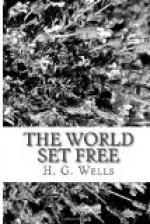Always before in the development of warfare the shells and rockets fired had been but momentarily explosive, they had gone off in an instant once for all, and if there was nothing living or valuable within reach of the concussion and the flying fragments then they were spent and over. But Carolinum, which belonged to the beta group of Hyslop’s so-called ‘suspended degenerator’ elements, once its degenerative process had been induced, continued a furious radiation of energy and nothing could arrest it. Of all Hyslop’s artificial elements, Carolinum was the most heavily stored with energy and the most dangerous to make and handle. To this day it remains the most potent degenerator known. What the earlier twentieth-century chemists called its half period was seventeen days; that is to say, it poured out half of the huge store of energy in its great molecules in the space of seventeen days, the next seventeen days’ emission was a half of that first period’s outpouring, and so on. As with all radio-active substances this Carolinum, though every seventeen days its power is halved, though constantly it diminishes towards the imperceptible, is never entirely exhausted, and to this day the battle-fields and bomb fields of that frantic time in human history are sprinkled with radiant matter, and so centres of inconvenient rays.
What happened when the celluloid stud was opened was that the inducive oxidised and became active. Then the surface of the Carolinum began to degenerate. This degeneration passed only slowly into the substance of the bomb. A moment or so after its explosion began it was still mainly an inert sphere exploding superficially, a big, inanimate nucleus wrapped in flame and thunder. Those that were thrown from aeroplanes fell in this state, they reached the ground still mainly solid, and, melting soil and rock in their progress, bored into the earth. There, as more and more of the Carolinum became active, the bomb spread itself out into a monstrous cavern of fiery energy at the base of what became very speedily a miniature active volcano. The Carolinum, unable to disperse, freely drove into and mixed up with a boiling confusion of molten soil and superheated steam, and so remained spinning furiously and maintaining an eruption that lasted for years or months or weeks according to the size of the bomb employed and the chances of its dispersal. Once launched, the bomb was absolutely unapproachable and uncontrollable until its forces were nearly exhausted, and from the crater that burst open above it, puffs of heavy incandescent vapour and fragments of viciously punitive rock and mud, saturated with Carolinum, and each a centre of scorching and blistering energy, were flung high and far.
Such was the crowning triumph of military science, the ultimate explosive that was to give the ‘decisive touch’ to war....
Section 5




